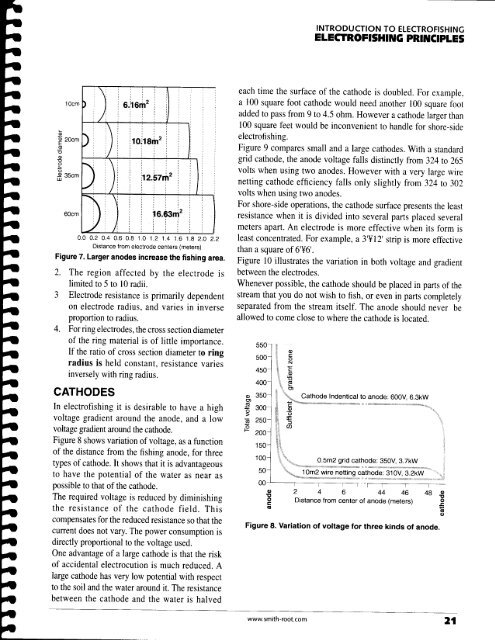Introduction to Electrofishing
Introduction to Electrofishing
Introduction to Electrofishing
You also want an ePaper? Increase the reach of your titles
YUMPU automatically turns print PDFs into web optimized ePapers that Google loves.
INTRODUCTION TO ELECTROFISHINGETECTROFTSHIiIG PRIIUCIPTES6.il6rh2) 10,18rn')2.tt7ril 2Il6.S3nt'0.00.20.4 0.60.8 1.01.2 1.4 1.61.82.O 2.2Distance from electrode centers (meters)Figure 7. Larger anodes increase the fishing area.2. The region affected by the electrode islimited <strong>to</strong> 5 <strong>to</strong> 10 radii.3 Electrode resistanceprimarily dependen<strong>to</strong>n electrode radius, and varies in inverseproportion <strong>to</strong> radius.4. Forring electrodes, the cros section diameterof the ring material is of little importance.If the ratio of cross section diameter <strong>to</strong> ringradius is held constant. resistance variesinversely with ring radius.CATHODESIn electrofishing it is desirable <strong>to</strong> have a highvoltage gradient around the anode, and a lowvoltage gradient around the cathode.Figure 8 shows variation of voltage, as a functionof the distance from the fishing anode, for threetypes of cathode. It shows that it is advantageous<strong>to</strong> have the potential of the water as near aspossible <strong>to</strong> that of the cathode.The required voltage is reduced by diminishingthe resistance of the cathode field. Thiscompensates for the reduced resistance so that thecurrent does not vary. The power consumption isdirectly proportional <strong>to</strong> the voltage used.One advantage of a large cathode is that the riskof accidental electrocution is much reduced. Alarge cathode has very low potential with respect<strong>to</strong> the soil and the water around it. The resistancebetween the cathode and the water is halvedeach time the surface of the cathode is doubled. For example,a 100 square foot cathode would need another 100 square footadded <strong>to</strong> pass from g <strong>to</strong> 4.5 ohm. However a cathode larger than100 square feet would be inconvenient <strong>to</strong> handle for shore-sideelectrofishing.Figure 9 comparesmall and a large cathodes. With a standardgrid cathode, the anode voltage falls distinctly from 324 <strong>to</strong> 265volts when using two anodes. However with a very large rvirenetting cathod efficiency falls only slightly from324 ro 302volts when using two anodes.For shore-side operations, the cathode surface presents the leastresistance when it is divided in<strong>to</strong> several parts placed severalmeters apart. An electrode is more effective when its form isleast concentrated. For example , a 3'Yl2' strip is more effectivethan a square of 6'Y6'.Figure 10 illustrates the variation in both voltage and gradientbetween the electrodes.Whenever possible, the cathode should be placed in parts of thestream that you do not wish <strong>to</strong> fish, or even in parts completelyseparated from the stream itself. The anode should never beallowed <strong>to</strong> come close <strong>to</strong> where the cathode is located.o(!= o(d500450400350200150o)N=(It\... Cathode Indentical <strong>to</strong> anode: 6OOV, 6.3kW=\\\\\\\\\\NN\\.o'\ro \ .EU)1000.5m2 grid cathode: 350V, S.7kW\llr..ooN5010m2 wire netting cathode: 310V,3.2kW\slss*s*.-...*.rr,.,.\00c) 2 4 6 4 4 4 6 4R O't<strong>to</strong>c(g Distance from center of anode (meters)Figure 8. Variation of voltage for three kinds of anode.www. smith-root.com21E oo o










